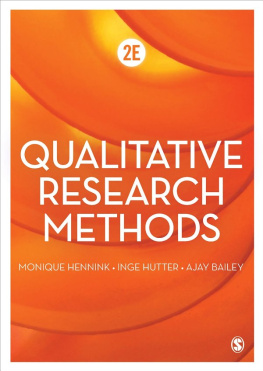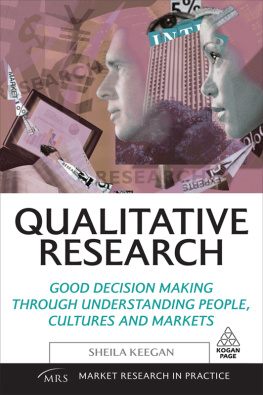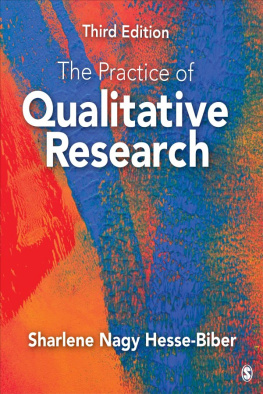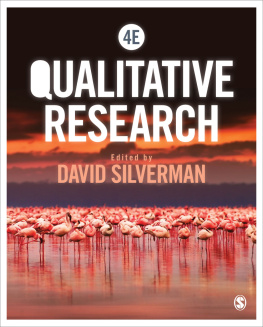FOCUS GROUPS AS QUALITATIVE RESEARCH
DAVID L. MORGAN
Portland State University
Qualitative Research Methods Series
Volume 16
Second Edition
SAGE PUBLICATIONS International Educational and Professional Publisher Thousand Oaks London New Delhi |  |
Copyright 1997 by Sage Publications, Inc.
All rights reserved. No part of this book may be reproduced or utilized in any form or by any means, electronic or mechanical, including photocopying, recording, or by any information storage and retrieval system, without permission in writing from the publisher.
For information address:
 | SAGE Publications, Inc. 2455 Teller Road Thousand Oaks, California 91320 E-mail: |
| SAGE Publications Ltd. 6 Bonhill Street London EC2A 4PU United Kingdom |
| SAGE Publications India Pvt. Ltd. M-32 Market Greater Kailash I New Delhi 110 048 India |
Printed in the United States of America
Library of Congress Cataloging-in-Publication Data
Morgan, David L.
Focus groups as qualitative research / David L. Morgan. 2nd ed.
p. cm. (Qualitative research methods ; v. 16)
Includes bibliographical references and index.
ISBN 0-7619-0342-9 (alk. paper). ISBN 0-7619-0343-7 (pbk. : alk. paper)
1. Focused group interviewing. 2. Social sciencesResearch-Methodology. I. Title. II. Series.
| H61.28.M67 1997 |
| 300.723dc20 | 96-25389 |
01 02 03 10 9 8 7 6
| Acquiring Editor: | Peter Labella |
| Editorial Assistant: | Francis Borghi |
| Production Editor: | Sherrise Purdum |
| Production Assistant: | Denise Santoyo |
| Typesetter/Designer: | Danielle Dillahunt |
| Print Buyer: | Anna Chin |
CONTENTS
Only a decade ago, focus groups were virtually unknown to social scientists. Now, their use in academic settings as well as outside is vast and ever-growing. In this extensively revised and updated edition of Focus Groups as Qualitative Research, David Morgan provides an excellent guide to focus groups. He carefully considers their many uses in the research enterprise and discusses effective planning and research design for focus groups. Finally, he provides concrete and practical advice on how to conduct and analyze focus groups and considers additional possibilities.
One of the best-selling titles in the Qualitative Research Methods series, this revision will be of value to qualitative researchers in every academic discipline as well as those in nonacademic settings.
John Van Maanen
Peter K. Manning
Marc L. Miller
Much has changed during the 10 years since I began work on the first edition of this book. The most rewarding of these changes is the fact that focus groups are now a much more widely practiced research method within the social sciences. Indeed, this increasing experience with focus groups in the social sciences is the primary reason for this new edition. Ten years ago, nearly all the recent writing on focus groups came from marketing research. Today, there is a sizable literature about focus groups in anthropology, communication studies, education, evaluation, nursing, political science, psychology, public health, sociology, and many other disciplines. Indeed, more than half the references cited in this book were published since the previous edition.
During those 10 years, I too have been busy. In that time, I have conducted more than 20 research projects involving more than 100 focus groups, as well as leading numerous training sessions and workshops. Thinking back over these past few years makes me realize how much I owe to those who were there at the beginning: Pamela G. Smith, who first drew my attention to focus groups, and Margaret Spanish, who both assisted me with and coauthored my first work in this field. Of course, I would never have been prepared to take advantage of those opportunities without the graduate training that I received from Bill Gamson in working with groups and from the late David Street in qualitative methods.
It takes a team of people working together to make a focus groups project succeed. It has taken many more to help focus groups become better known. I have been fortunate to have good company in sharing these tasks. One particularly pleasant aspect of my work on focus groups has been the collaboration that Richard Krueger and I have developed. Although Dick and I had never met when Sage published our two books on focus groups in 1988, we have since had many chances to talk and work together in ways that continue to be enlightening to me. Over the years, I have also benefited from repeated exchanges with my colleagues Robin Jarrett, John Knodel, and Kerth OBrien, as well as from discussions with many other social scientists who have helped me to pursue my interest in focus groups, including Duane Alwin, Gene Anderson, Janet Mancini Billson, Linda Boise, Edgar Butler, Martha Ann Carey, Ben Crabtree, Ted Fuller, Bill Gamson, Bob Hanneman, John Kennedy, Will Miller, Jan Morse, Eliot Smith, Richard Zeller, and Mary Zinkin. I have been fortunate to work with many talented graduate students, and I especially recognize Paula Carder, Marie Duncan, Steve March, and Alice Scannell for their assistance with multiple projects over the years. In addition, like so many other Sage authors, I owe a special debt to Mitch Allen for all his assistance and insights over the years. Finally, I want to thank my wife, Susan Wladaver-Morgan, not just for her consistently professional editing of my work but also for all the many other ways in which she has supported my work.
FOCUS GROUPS AS QUALITATIVE RESEARCH
DAVID L. MORGAN
Portland State University
In a church meeting room, a group of widows compare their experiences. One woman complains that other people wanted her to stop grieving in 6 months, but that it really takes much longer. Another woman produces murmurs of agreement throughout the groups when she adds that the second year is sometimes harder than the first (Morgan, 1989).
In a living room, a group of working people discuss their views of major political topics such as affirmative action, nuclear power, and the Arab-Israeli conflict. One striking element of their conversations is the number of personal connections that they make to these issues, even when they react to examples of how the mass media portray these topics (Gamson, 1992).
In a rural village in Thailand, two groups, one of young men and one of young women, discuss the number of children they want to have and how this has changed since their parents day. Elsewhere in the same village, groups from the older generation discuss how they feel about this issue and how things have changed for their children. Later, the researcher analyzes tapes of these discussions to compare the thoughts and experiences of men and women in the older and younger generation (Knodel, Havanon, & Pramualratana, 1984). In Chicago, a group of young African American mothers talk about what it is like to be on welfare. They all agree that it is a hard life, but to hear them tell it they have what it takes to get along despite their obvious problems. Still, as the discussion wears on, their stories are more and more about how hard it is and less about their own ability to rise above their circumstances (Jarrett, 1993).









